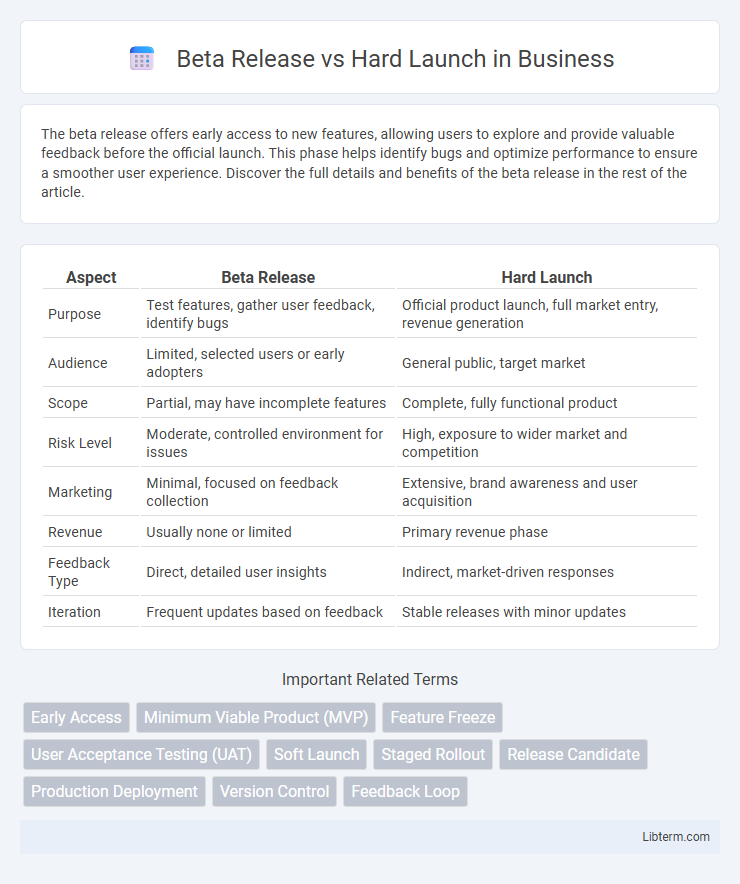The beta release offers early access to new features, allowing users to explore and provide valuable feedback before the official launch. This phase helps identify bugs and optimize performance to ensure a smoother user experience. Discover the full details and benefits of the beta release in the rest of the article.
Table of Comparison
| Aspect | Beta Release | Hard Launch |
|---|---|---|
| Purpose | Test features, gather user feedback, identify bugs | Official product launch, full market entry, revenue generation |
| Audience | Limited, selected users or early adopters | General public, target market |
| Scope | Partial, may have incomplete features | Complete, fully functional product |
| Risk Level | Moderate, controlled environment for issues | High, exposure to wider market and competition |
| Marketing | Minimal, focused on feedback collection | Extensive, brand awareness and user acquisition |
| Revenue | Usually none or limited | Primary revenue phase |
| Feedback Type | Direct, detailed user insights | Indirect, market-driven responses |
| Iteration | Frequent updates based on feedback | Stable releases with minor updates |
Introduction to Beta Release and Hard Launch
Beta release serves as a preliminary rollout of a product to a limited audience, facilitating real-world testing and feedback collection to identify bugs and usability issues before a full launch. Hard launch signifies the official public introduction of the product, marked by full availability, extensive marketing efforts, and a commitment to ongoing customer support. Understanding the differences between beta release and hard launch is crucial for strategic planning, user engagement, and product development optimization.
Defining Beta Release: Key Features
Beta release is a pre-launch phase where software is distributed to a limited audience for real-world testing and feedback collection. Key features include identifying bugs, assessing usability, and validating product performance under varied user conditions. This stage helps developers refine functionality and enhance stability before the hard launch.
What is a Hard Launch?
A hard launch is the official introduction of a product or service to the entire target market without prior limited testing or feedback phases. It involves full-scale marketing, distribution, and customer access, aiming for immediate wide adoption and revenue generation. This approach contrasts with beta release, where the product is initially available to a select group for testing and iterative improvements before the final launch.
Objectives of Beta Releases
Beta releases aim to identify and resolve software bugs by exposing the product to a controlled group of real users, enabling valuable feedback on functionality and user experience. This testing phase helps optimize performance, assess scalability, and validate feature effectiveness before official launch. Beta testing objectives prioritize enhancing product stability, gathering actionable insights, and minimizing post-launch risks through iterative improvements.
Goals of a Hard Launch
A hard launch aims to maximize product visibility and user acquisition by making the product fully available to the target market without restrictions or testing phases. It focuses on establishing strong market presence, generating revenue, and gathering comprehensive user feedback to support future updates. Effective marketing campaigns and robust infrastructure are critical to sustaining user engagement and ensuring a smooth transition from development to widespread adoption.
Pros and Cons of Beta Releases
Beta releases allow developers to gather real user feedback, identify bugs, and improve product stability before a full launch, reducing the risk of widespread issues. However, beta versions may present an incomplete or unstable user experience, potentially affecting brand reputation and user retention during the testing phase. Controlled access to beta releases helps manage feedback quality and scope, but limited exposure can delay broader market validation and adoption insights.
Advantages and Disadvantages of Hard Launches
Hard launches offer the advantage of immediate full-scale market presence, generating quick user feedback and revenue potential. However, they carry higher risks such as untested features leading to negative user experience and limited flexibility to pivot after release. Companies must weigh the benefits of rapid exposure against the challenges of potential technical issues and brand reputation impact.
When to Choose Beta Release Over Hard Launch
Choosing a beta release over a hard launch is ideal when seeking early user feedback to identify bugs and improve product features before full market exposure. Beta testing helps gather real-world data on user experience and performance, enabling developers to iterate and ensure stability. Organizations aiming to minimize risks and fine-tune functionality typically opt for a beta release to validate the product under controlled conditions.
Industry Examples: Beta vs Hard Launch
Tech giants like Microsoft often utilize beta releases to gather user feedback and identify bugs before a hard launch, exemplified by Windows 10's extensive beta testing phase. In contrast, companies like Apple prefer hard launches to create significant market impact, as seen in the immediate release of new iPhone models without prolonged public testing. This strategic choice between beta and hard launches significantly influences product reception and market performance across the software and hardware sectors.
Conclusion: Choosing the Right Approach
Selecting between a beta release and a hard launch depends on your product's complexity and market readiness. Beta releases allow for real-user feedback and iterative improvements, reducing risks before full-scale deployment. Hard launches suit products with established demand, aiming for immediate market impact and maximum visibility.
Beta Release Infographic

 libterm.com
libterm.com